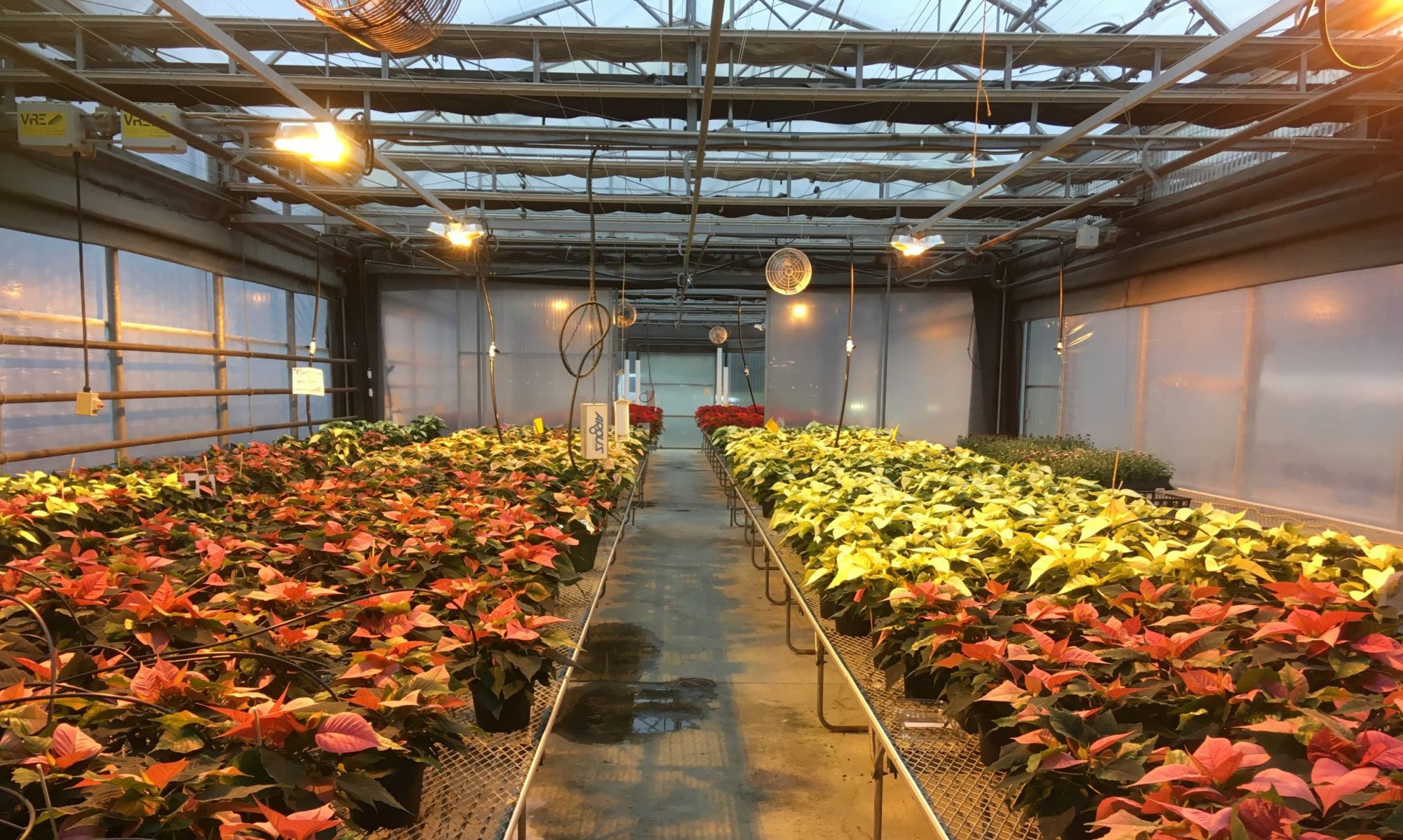Environmental Conditions:
Week 41 saw a change in weather from sunny clear skies of last week to cloudy and rain this week. This week two (2) pivotal events happened in the greenhouses as we switched our focus from vegetative to generative (flowering) growth. Frist, we initiated black out. Poinsettias as short day sensitive plants meaning a shortened day length triggers the plants into generative growth. We initiated black out by using Argus Controls for the roof black out curtain and the timer for the side black out curtains. The second change we made was to create two (2) distinctive temperature zones in the day and night period.
Day: Heating Setpoint 20C | Cooling Setpoint 22C
Night: Heating Setpoint 18C | Cooling Setpoint 20C
We used Argus Controls to create two distinctive temperature zones. Our day period, which corresponds directly to our literal day period (light is getting to the crop) is running higher than our night period; this means we are running a positive diff. A negative diff is if we were running a warmer night period than day period.
We needed to create a greater and distinct difference between the day and night temperatures to trigger generative growth. Its important to remember that our temperature zones are dynamic, and we can change the, based on our height measurements and our visual inspections of our crop.
Supplemental Lighting:
This week we initiated the black out curtain and are running a 9-hour day and a 15-hour night to trigger the plants into generative growth. This is essentially what is going to turn our poinsettias red, white, or pink.
Hours of Black Out: 15 hours – 5pm to 8am.
Nutrient:
EC target is 1.5 – 2.0 pH target is 5.7 – 6.3
EC: The EC’s ranged from 0.4 – 1.6 again this week.
pH: We are starting to see an upward trend in the pH which is a good sign since last week the pH was concerningly low. We also switched from the Mg fertilizer to the CaN03 fertilizer to continue developing the roots and help bract development.
Watering/Fertilizer:
The students assessed soil moisture on Tuesday in our face to face classes. In addition to the EC measurements we used the plant heights to guide us towards our decision on what (if anything) we should water with. Our plants are sitting around 22cm and this information helps us decide what, if anything, to fertilizer with.
Now that we have started the black out it is increasingly important to be accurate in our poinsettia height measurements. Once we have triggered generative growth the plants will start to focus their growth on flowering and less towards vegetative growth meaning we have less flexibility when adjusting temperatures to direct crop height.
Observations:
- All the poinsettias are spaced and are currently being hooked up to our drip irrigation system. Its critical that we get all the poinsettias connected to the drop lines so that we have increase our labour efficiency and create uniform applications of watering/fertilizing to our crop. The 4” poinsettias in the flood table are looking crowded already as they grow into the surrounding space.
- The students have been taking weekly height measurements and we can see that our crop is (generally) increasing in height each week. Its critical we use correct height measuring techniques to use the most accurate information to base our decisions from. Our crop average is 23.5cm with Titan Pink pulling up the average at 26cm!
- You will recall that in our vegetative growth phase we ran the day and night periods the same to keep the growing environment stable and with out extreme fluctuations in temperature for our plants. Now, we have created two distinct temperature zones (see above) which will help in triggering our plants into generative growth. We will continually assess poinsettia heights to make environmental decisions to direct crop growth.
- We have started our IPM control system by setting up for the HORT 112T yellow sticky card assignment. The students put their yellow sticky card in the crop and in two weeks will come back to identify the insects found on the sticky card and communicate with the group about their findings. Together, the class will make recommendations to the growers. You will recall that we are focusing our efforts on scouting and monitoring for whitefly, fungus gnats, thrips, and mealy bugs.
- This week we did not use the side walls for passive venting very much due to lower outdoor temperatures and rain at the end of the week. The shade curtain is also being use less as we are seeing fewer sunny days and our crop is being less impacted by direct solar radiation meaning we are not having to protect the crop as much. We are relying on our HPS (high pressure sodium) lights in the greenhouses now to create the day period to give our crop enough light hours to photosynthesize.
- Moving forward it will be critical to manage greenhouse environment and pest pressure to ensure crop health throughout the next 7.5-8 weeks until sales. Speaking of sales, it is time to turn our focus to selling our crop! Please look at the week 41 section of VIULearn for updated sale information.
*Note that our home crop is yours to keep and we won’t be selling it through the Paine Centre.



